Some of my favorite bonsai work is repotting trees for the first time.
I never take for granted that new trees in the garden have healthy roots and perfect root-bases. Sometimes they do, but other times they don’t.
Until I repot a tree, I don’t have a great idea about what condition the soil or roots are in. And when I don’t know what’s going on beneath the surface of the soil, I’m limited in the amount of work I can do on a tree as I don’t have a good idea how it will respond.
Here’s a field-grown trident maple that spent the past 1-2 years in nursery mix.

Trident maple planted in nursery soil – January, 2017
My goal was to bare-root the tree by removing all of the nursery soil, but first I had to get it out of the pot. This wasn’t straightforward as a solid mat of roots had formed below the container.
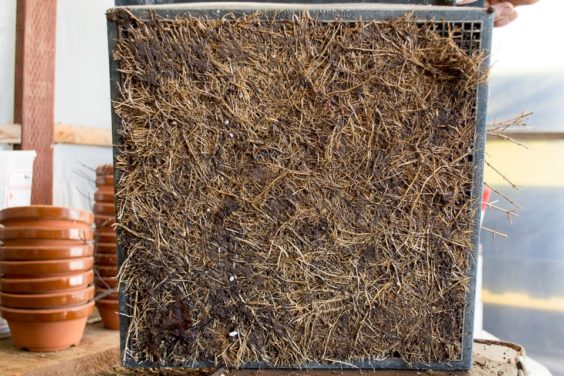
Mat of roots under the flat
I used a mattock to peel back the roots.
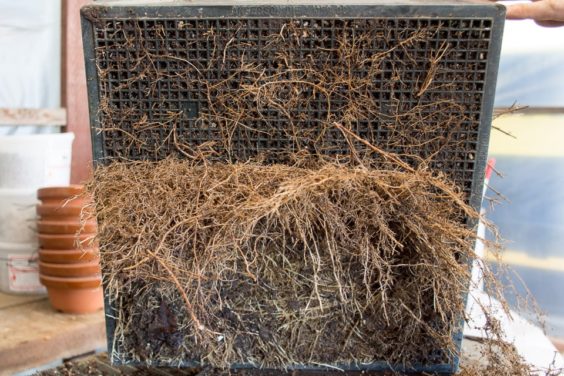
Peeling away the roots
Once the roots were out of the way, the tree came out of the flat easily.
Next, I worked on removing the soil with chopsticks and root hooks. After the rootball was fairly clean, it was time to hose off the remaining soil. Here’s the tree after rinsing off the last of the soil.
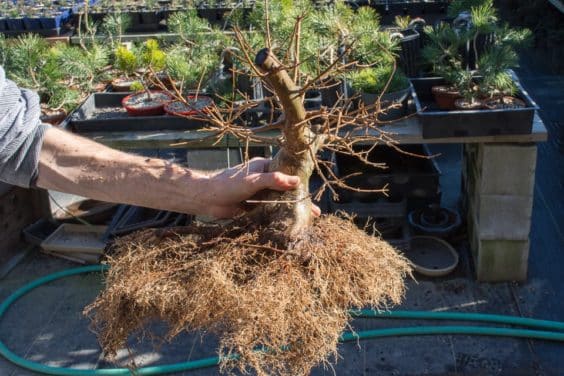
After washing away the nursery soil
And here it is from underneath.
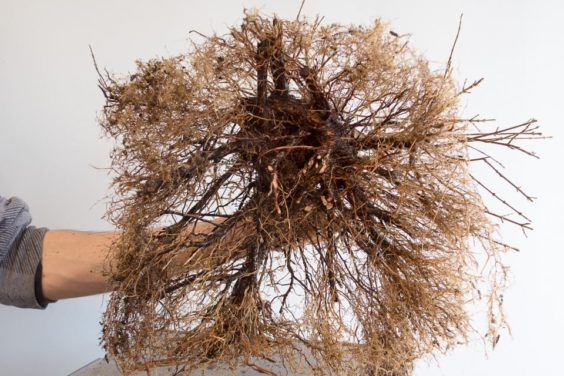
The underside of the rootball
The resulting rootball looked great – a perfect starting point for developing the tree as bonsai.
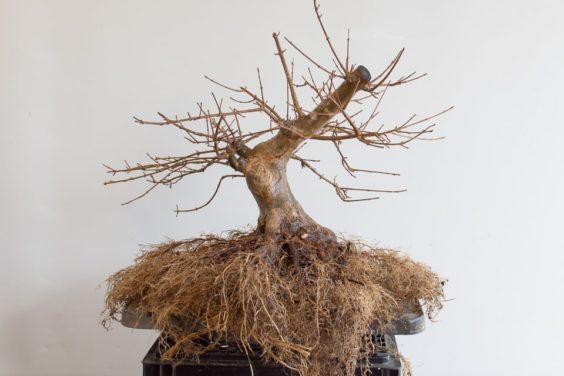
Bare-rooted and ready to go – see “Repotting a trident maple bonsai” for a review of repotting basics
Why talk about repotting in summer? Because it’s important to consider root health before working on trees. Plus, now is a great time to line up repotting projects for next year. Are there new trees in your collection that you’re excited to repot when you get the chance? Feel free to share in the comments below.
Subscribe to Bonsai Tonight
New Posts Delivered Every Tuesday and Friday
Jason Dsouza says
repotting is such a important exercise. However some species cant have all the soil washed away – right? Nice article with step by step clear pics.
Jonas Dupuich says
Thanks Jason, your comment is right on – only some varieties can be safely bare-rooted, and bare-rooting can generally only happen when the trees are dormant.
Ray says
Was this a nursery potting mix? It looks like a good mix of componets for growth. Great root system.
Jonas Dupuich says
Hi Ray – yes, this was a (bonsai) nursery mix, but a good mix with pumice that encouraged so many roots. It was a great starting point!
Alessandro says
Hi Jonas! I never do this kind of work in full summer! Obviously this is not the first time for you, but don’t you think that it may be dangerous at this time of the year to defoliate, bare-rooting, choose the good root and cut off the wrong one and repotting at the same time? Thank you, Alessandro.
Jonas Dupuich says
Hi Alessandro – Sorry not to clarify, the repotting happened in winter. (I mentioned this in the last post and just added a note to this post.) You’re quite right that doing all of that work at once would be very stressful for the tree!
Brian McGrath says
Hi Jonas
I candeled my jbp June the 1st. I live on Vancouver island so we have a mild climate. How big should my summer buds be at this time. Mine are about 5 mm. Now is that on par with what they should be. The tree has some browning of needles, and as always one gets peranoic with anything brown in bonsai
Thank you
Brian
Jonas Dupuich says
Hi Brian – that sounds totally normal to me. The bigger question is how they’ll look by October or November. At that point you’ll know if you need to decandle earlier. I know a number of people who decandle pines the last week of May in Seattle.
Something else to watch for is the effect of decandling early multiple years in a row. Although the tree might come out great one year, it might be weak the next. The main thing is to track what you’re doing and make adjustments along the way.
Marty Weiser says
Jonas,
Any comments on how long and where the trident grew in the ground before it was placed in the Anderson flat for 1-2 years to help develop the root system? I need to move a couple of small ones form flat trays used to develop the start of a nice root system to the ground to thicken. I am further north so it will take longer, but it is good to get more data to use.
I agree that repotting to get the roots on the proper track is a really cool aspect of bonsai development. You open the present to see what is there, do some work to try to make it a better present, and hide it away for 2-4 years with the hope of having a pleasant surprise when you open it again.
Marty
Jonas Dupuich says
Hi Marty – I like the present analogy 🙂 As for the tree, I don’t know how old the tree is or how long it was in the ground but it came from Lone Pine Gardens in Santa Rosa, California.
Vinny Chirayil says
Hi Jonas, the root ball is quite impressive ! Was the Anderson flat resting on ground soil or some substrate ? If the flat was kept on concrete or a bench, i can’t imagine the roots coming out like this. Was it intentionally kept over a medium ? Pot design – If this flat had just 2 large holes on the base, like a bonsai pot instead of a perforated base, what difference in plant growth (specially roots) would you expect ? Did you have a particular reason for choosing flats instead of a bulb pan pot ?
Jonas Dupuich says
Hi Vinny – I expect the flat was laying on ground covered with weed cloth at the nursery where it was grown and it was on a wood bench in my garden before repotting. This was the first time I’ve repotted the tree. I’ve seen roots like this on both concrete and on wood benches – the main variable is how often the tree is moved and how wet the area below the pot is. I wouldn’t expect any difference in root quality based on pot design as the tree was only in the flat for a short time (1-2 years).